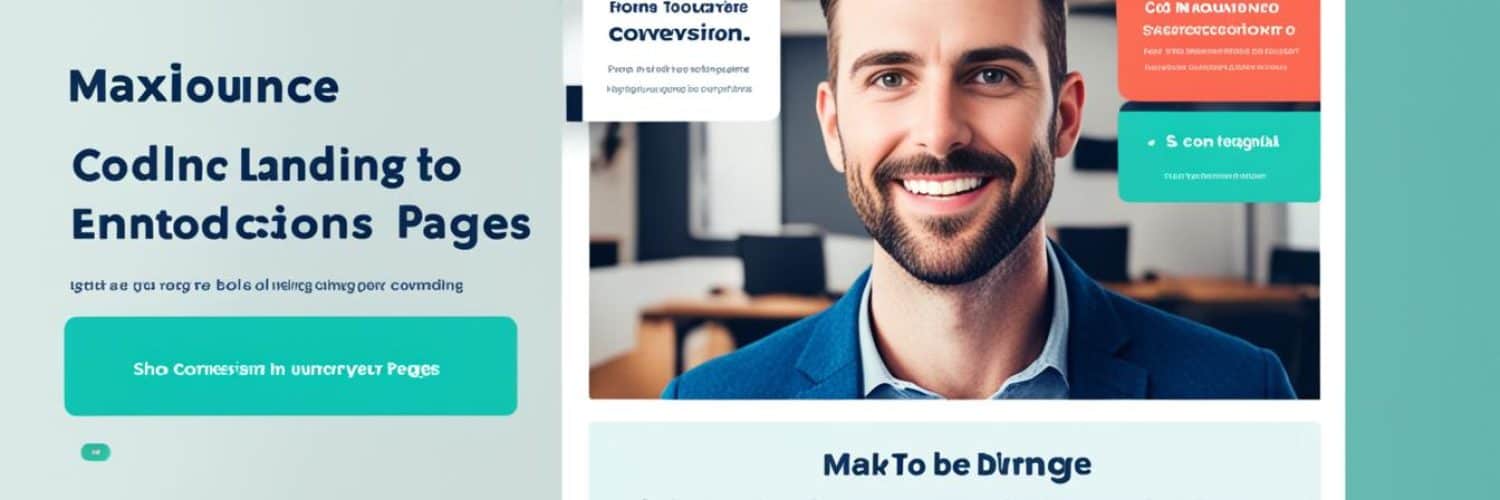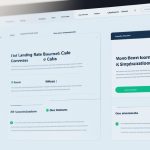Are you struggling to optimize your landing pages for maximum conversions and lead generation? Look no further. Unbounce, the leading landing page builder, is here to revolutionize your digital marketing strategies. With its powerful features and best practices, Unbounce can help you unlock the true potential of your website and drive unmatched results.
Key Takeaways:
- An introduction to Unbounce, the powerful landing page builder.
- How Unbounce can significantly increase your conversion rates and boost lead generation.
- The importance of website optimization and digital marketing strategies in improving your business performance.
Understanding Landing Page Optimization (LPO)
Landing page optimization (LPO) is a crucial aspect of digital marketing that focuses on making continuous improvements to each element of a landing page. The goal is to drive leads, signups, or sales by optimizing the page for higher conversion rates. LPO involves utilizing data-backed insights and implementing best practices to enhance the performance of landing pages.
The Essence of LPO in Digital Marketing
In the realm of digital marketing, a well-optimized landing page can significantly impact the success of your lead generation and sales efforts. By implementing LPO strategies, you can create a landing page that engages your target audience and persuades them to take the desired action, such as filling out a form or making a purchase. Through careful analysis of user behavior and data, LPO enables you to optimize various elements of the landing page, such as the headline, messaging, visuals, and call-to-action, to improve its effectiveness.
Effective landing page optimization ensures that your messaging aligns with the expectations of your target audience, resulting in increased engagement and conversions. By continuously testing and refining different elements of your landing page, you can improve its performance and achieve better overall results for your digital marketing campaigns.
Why LPO is Crucial for Lead Generation and Sales
Landing page optimization plays a critical role in driving lead generation and sales. A well-optimized landing page appeals to your target audience, effectively communicates your value proposition, and guides visitors towards the desired action. By implementing LPO strategies, you can:
- Enhance the user experience: By optimizing the layout, design, and content of your landing page, you can create a seamless user experience that captures your visitors’ attention and keeps them engaged.
- Increase conversion rates: By carefully crafting compelling headlines, persuasive copy, and visually appealing elements, you can increase the likelihood of visitors converting into leads or customers.
- Improve campaign performance: LPO enables you to identify and address shortcomings in your landing page that may be preventing you from achieving optimal results. By making data-driven improvements, you can enhance your campaign performance and maximize your return on investment.
In summary, landing page optimization is a key component of any successful digital marketing strategy. By constantly refining and optimizing your landing pages, you can drive higher conversion rates, generate more leads, and ultimately boost sales.
Navigating the Unbounce Platform
The Unbounce platform offers a variety of key features that make it easy to create and optimize landing pages. With Unbounce, you can leverage a powerful landing page builder, utilize customizable templates for rapid deployment, and seamlessly integrate with your existing marketing stack. Let’s explore these key features in detail.
Key Features of the Unbounce Landing Page Builder
The Unbounce landing page builder is a drag-and-drop tool that allows you to create stunning and high-converting landing pages without any coding knowledge. With its intuitive interface, you can easily add and customize elements, such as text, images, forms, and buttons, to design landing pages that align with your brand and goals. The flexibility of the builder enables you to create unique and engaging experiences for your visitors.
Utilizing Templates for Rapid Deployment
To save time and streamline your landing page creation process, Unbounce offers a wide range of customizable templates. These templates are professionally designed and optimized for conversions, allowing you to quickly deploy landing pages that have been proven to perform well. By selecting a template that suits your campaign objectives, you can focus on tailoring the content and messaging to meet your specific needs, rather than starting from scratch.
Integrating Unbounce with Your Marketing Stack
To maximize the effectiveness of your marketing efforts, it is essential to integrate Unbounce with your existing marketing stack. Unbounce provides seamless integrations with popular marketing tools, such as email marketing platforms, customer relationship management (CRM) systems, and analytics platforms. By integrating Unbounce with your marketing stack, you can easily capture and sync lead data, track conversion metrics, and automate follow-up actions, ensuring a cohesive and efficient workflow.
Incorporating Best Practices for Higher Conversion Rates
To achieve higher conversion rates on your landing pages, it is crucial to incorporate best practices into your design and content. By following these proven methods, you can optimize your pages for better results and maximize the impact of your marketing efforts.
Message Match: Aligning Ads with Landing Page Content
One of the key best practices is to ensure message match between your ads and landing page content. When a user clicks on an ad, they expect to see relevant information on the landing page that matches what was promised in the ad. By aligning your messaging, you create consistency and build trust with your visitors, resulting in an improved user experience and higher conversion rates.
The Impact of Visual Hierarchy and Above-the-Fold Content
Visual hierarchy refers to the arrangement of elements on your landing page in a way that guides the user’s attention and emphasizes the most important information. By strategically placing key content elements above the fold, within the visible area of the page without scrolling, you can capture users’ attention and encourage them to take desired actions.
Visual hierarchy can be achieved through the use of contrasting font sizes, colors, and visual cues such as arrows or buttons. By creating a visually appealing and intuitive layout, you can guide users through your landing page and lead them towards conversions.
Remember, the content placed above the fold should be engaging and relevant to the user’s needs, compelling them to continue scrolling and exploring the rest of the page.
Leveraging Unbounce for A/B Testing
Unbounce offers a powerful A/B testing feature that allows you to compare different variations of your landing page to determine which one performs better. With this feature, you can test various elements such as headlines, images, and calls-to-action to optimize your landing page for higher conversions.
A/B testing, also known as split testing, is an essential technique in conversion rate optimization. It enables you to make data-driven decisions and identify the most effective design, messaging, and layout for your landing page. By leveraging Unbounce’s A/B testing feature, you can analyze the performance of different variations and iterate on your landing page to improve its conversion rate.
A/B testing provides valuable insights into your audience’s preferences, allowing you to make informed decisions about the elements that resonate best with them. By testing different features, you can identify the winning variation that drives the most conversions, resulting in a more effective and profitable landing page.
“A/B testing allows you to experiment with different options and measure their impact on your conversion rate. It’s like having a crystal ball that reveals the hidden secrets to higher conversions.” – Marketing Expert
To get started with A/B testing in Unbounce, simply create multiple variations of your landing page, each with a unique element you want to test. This could include different headlines, images, colors, or CTA buttons. Unbounce will then randomly display the variations to different visitors, enabling you to see which version performs better.
By analyzing the results of your A/B tests, you can make data-backed decisions to optimize your landing page for better conversions. Continuously testing and refining your landing page based on visitor behavior and preferences will ensure that you are consistently improving your conversion rates and maximizing your results.
With Unbounce’s A/B testing feature, you can unlock the full potential of your landing page and achieve higher conversion rates. Experiment with different variations, track the results, and iterate on your design to create a landing page that truly resonates with your target audience.
Essentials of Conversion Rate Optimization
Conversion rate optimization (CRO) is the practice of increasing the percentage of website visitors who take a desired action. It is a vital aspect of any digital marketing strategy, as optimizing your conversion rates can lead to higher engagement, increased sales, and improved overall performance.
Identifying Your Conversion Goals
Before you can start optimizing your conversion rates, it is crucial to clearly define your specific conversion goals. These goals can vary depending on your business objectives and may include actions such as making a purchase, filling out a form, signing up for a newsletter, or requesting more information.
To identify your conversion goals, consider the desired actions you want your website visitors to take and align them with your overall business objectives. By having a clear understanding of your conversion goals, you can then implement targeted strategies and tactics to maximize your results.
Optimizing Calls-to-Action for Improved Engagement
Calls-to-action (CTAs) play a crucial role in conversion rate optimization. A compelling and well-optimized CTA can significantly increase user engagement and encourage visitors to take action.
When optimizing your CTAs, consider the following best practices:
- Clear and concise: Ensure your CTAs are easy to understand and clearly communicate the desired action.
- Contrasting colors: Use colors that stand out from the rest of the page to draw attention to your CTAs.
- Placement: Position your CTAs prominently on the page, making them easily visible and accessible.
- Compelling copy: Use persuasive language that encourages visitors to take action, emphasizing the benefits they will receive.
- A/B testing: Continuously test different variations of your CTAs to determine which ones perform best and drive the highest engagement.
By optimizing your calls-to-action, you can improve user engagement, increase conversions, and ultimately achieve better results from your conversion rate optimization efforts.
Designing with User Intent in Mind
When it comes to designing landing pages, one of the most important factors to consider is user intent. Understanding user intent allows you to create landing pages that effectively cater to the needs and expectations of your visitors. By aligning your design with user intent, you can create a user-centric experience that enhances user engagement and increases conversions.
Understanding Visitor Behavior and Expectations
Visitor behavior plays a crucial role in determining the success of your landing pages. By analyzing how visitors interact with your landing pages, you can gain valuable insights into their preferences and expectations. Understanding visitor behavior enables you to optimize your design elements, such as layout, navigation, and content placement, to better engage and guide your visitors towards your desired action.
Creating a User-Centric Experience on Landing Pages
To create a user-centric experience, it’s important to focus on designing landing pages that prioritize user needs and goals. Start by identifying the primary goal of each landing page and aligning all design elements towards achieving that goal. Consider factors such as intuitive navigation, clear and concise messaging, visually appealing visuals, and easy-to-use forms. By creating a user-centric experience, you can build trust with your visitors, improve their satisfaction, and ultimately increase conversions.

Boosting Lead Generation with Innovative Forms
In order to maximize lead generation, Unbounce provides innovative form features that can significantly enhance the effectiveness of your lead capture efforts. By leveraging these features, you can create forms that are not only easy to fill out, but also motivate visitors to provide their information willingly and confidently.
Unbounce’s form builder allows you to design and customize forms that align with your branding and capture the specific data you need to generate high-quality leads. With a user-friendly interface and intuitive controls, creating engaging and conversion-focused forms has never been easier.
One of the key advantages of Unbounce’s form features is the ability to integrate with various lead tracking and customer relationship management (CRM) systems. This enables you to seamlessly capture and organize lead data, ensuring efficient follow-up and nurturing of potential customers.
Another innovative aspect of Unbounce’s form functionality is the option to implement progressive profiling. With progressive profiling, you can collect additional information from returning visitors, gradually building a more comprehensive profile without overwhelming them with lengthy forms.
In addition, Unbounce offers advanced form validation and error handling, ensuring that visitors are guided through the form-filling process smoothly and without frustration. By providing real-time feedback and suggestions, you can minimize form abandonment and increase the number of completed submissions.
Furthermore, Unbounce allows you to embed forms on your landing pages with ease. Whether you want a simple inline form or a modal form that pops up dynamically, you have the flexibility to choose the most effective form layout for your specific lead generation goals.
By utilizing Unbounce’s innovative form features, you can optimize your lead generation efforts and capture valuable information from your website visitors. Whether you’re running an e-commerce store, a subscription-based service, or a B2B SaaS company, Unbounce provides the tools you need to generate leads and drive business growth.
Building Trust through Transparency and Authenticity
Building trust with your visitors is crucial for conversion optimization. When visitors trust your brand, they are more likely to engage with your landing pages and take the desired actions. Unbounce understands the importance of trust and offers features that help you establish transparency and authenticity.
The Role of Social Proof in Convincing Prospects
Social proof is a powerful tool in convincing prospects and building trust. It is the concept that people tend to follow the actions of others when they are uncertain about what to do. By showcasing social proof on your landing pages, you can provide evidence of your brand’s credibility and encourage visitors to trust your offerings.
Unbounce allows you to highlight social proof elements such as testimonials, reviews, and case studies. By incorporating these elements strategically, you can leverage the positive experiences of your customers to persuade prospects and instill confidence in your brand.
Earning Visitor Confidence with Secure Practices
Visitor confidence is closely tied to their perception of your website’s security. When visitors feel confident that their personal information is safe and secure, they are more likely to submit their data and convert. Unbounce prioritizes secure practices to ensure the protection of visitor information and maintain their trust.
Unbounce employs industry-standard security measures, such as data encryption and regular security audits, to provide a secure environment for your landing pages. By utilizing Unbounce’s secure practices, you can assure visitors that their information is in safe hands, fostering trust and increasing conversion rates.
“Trust is the foundation of any successful relationship. By establishing transparency, showcasing social proof, and incorporating secure practices, you can build trust with your visitors and boost conversions.”
Enhancing Landing Page Performance through Optimization
To maximize the effectiveness of your landing pages, it’s crucial to optimize various aspects that contribute to their performance. By focusing on key metrics and making informed design choices, you can create landing pages that load quickly, engage users, and drive conversions. In this section, we will explore how to utilize metrics to inform design choices and improve page speed for a better user experience.
Utilizing Metrics to Inform Design Choices
When optimizing your landing pages, it’s essential to rely on data-driven insights and metrics. By analyzing key performance indicators (KPIs) such as conversion rates, bounce rates, and click-through rates, you can identify areas for improvement and make informed design choices that enhance the user experience.
“Data-driven design decisions lead to more effective landing pages, as they are tailored to meet user expectations and preferences.”
By leveraging metrics, you can gain valuable insights into user behavior, preferences, and engagement patterns. This data can help you identify the strengths and weaknesses of your landing pages, enabling you to refine your design choices and optimize conversion pathways.
To effectively utilize metrics, consider the following:
- Analyze conversion rates to identify high-performing elements and replicate their success.
- Track bounce rates to identify potential issues and areas for improvement.
- Evaluate click-through rates to understand user engagement and optimize call-to-action placement.
- Use heatmaps and user recordings to visualize user interactions and identify opportunities for optimization.
By continuously monitoring and analyzing these metrics, you can make data-driven design choices that align with user expectations and maximize conversions.
Improving Page Speed for Better User Experience
Page speed is a critical factor in delivering a positive user experience. In today’s fast-paced digital landscape, users expect websites and landing pages to load quickly. A slow-loading page can lead to frustration, high bounce rates, and lost conversions.
Optimizing page speed involves various techniques, such as:
- Compressing images to reduce file size without sacrificing quality.
- Minifying CSS and JavaScript files to decrease load times.
- Leveraging browser caching to store frequently accessed files locally.
- Implementing content delivery networks (CDNs) to reduce server response times.
- Example of a page speed optimization process:
| Step | Action |
|---|---|
| 1 | Analyze current page load times and identify areas for improvement. |
| 2 | Optimize images by compressing them and using appropriate file formats. |
| 3 | Minify CSS and JavaScript files to reduce their size. |
| 4 | Implement browser caching to store static resources locally. |
| 5 | Consider using a CDN to deliver content faster. |
| 6 | Test and monitor page load times to validate the effectiveness of optimizations. |
By prioritizing page speed optimization, you can create a seamless user experience that keeps visitors engaged and increases the likelihood of conversions. Remember, fast-loading landing pages lead to happy users and improved performance metrics.

By utilizing metrics to inform design choices and improving page speed, you can enhance the performance of your landing pages and drive better user experiences. The next section will delve into the importance of mobile-first design in creating effective landing pages.
The Importance of Mobile-First Design in Landing Pages
With the increasing use of mobile devices, it is crucial to design landing pages with a mobile-first approach. Mobile-first design ensures that your landing pages are optimized for the smaller screens and touch interactions of mobile devices, providing a seamless user experience.
Unbounce, a leading landing page builder, understands the importance of mobile-first design and offers features that enable you to create responsive landing pages. These pages automatically adapt to different screen sizes and resolutions, ensuring that your message and call-to-action are prominently displayed on any device.
By adopting a mobile-first design strategy, you can capture the attention and interest of mobile users, who make up a significant portion of internet traffic. Responsive landing pages built with Unbounce allow you to deliver a consistent user experience, regardless of the device your visitors are using.
Mobile-first design also contributes to better search engine optimization (SEO). Search engines, such as Google, prioritize mobile-friendly websites and landing pages in their rankings. By ensuring that your landing pages are designed with mobile users in mind, you increase the chances of higher visibility and organic traffic.
Take a look at the image below to understand the impact of mobile-first design on landing pages:
As you can see, the layout and content of the landing page adjust and reflow to fit the smaller screen of a mobile device. The mobile-first design ensures that the important elements, such as the headline and call-to-action, are easily accessible and provide a seamless user experience.
Incorporating mobile-first design principles into your landing pages allows you to reach and engage a wider audience, increase conversions, and stay ahead in today’s mobile-driven digital landscape.
Unbounce and SEO Best Practices for Organic Traffic
To drive organic traffic to your landing pages and improve your search engine visibility, it’s essential to optimize your Unbounce pages using SEO best practices. By following these strategies and creating high-quality, keyword-rich content, you can attract more organic traffic and increase your chances of ranking well in search engine results. Let’s explore how you can optimize your Unbounce pages for search engines and create content that both ranks and converts.
Optimizing Your Unbounce Pages for Search Engines
When it comes to optimizing your Unbounce pages for search engines, there are several key factors to consider:
- Keyword Research: Conduct thorough keyword research to identify relevant keywords related to your business, target audience, and industry. Incorporate these keywords strategically into your page titles, headings, meta descriptions, and body content to improve your search engine rankings.
- Optimized Meta Data: Craft compelling meta titles and descriptions that not only include relevant keywords but also entice users to click through to your landing page. Be concise, clear, and compelling in your meta data to increase the chances of attracting organic traffic.
- URL Structure: Ensure your Unbounce page URLs are clean, descriptive, and include relevant keywords. Avoid using lengthy URLs with numbers or random characters. A clean URL structure can improve the visibility of your landing pages in search engine results.
- Heading Tags: Properly structure your content using heading tags (H1, H2, H3, etc.) to provide clear and organized information to search engines and users. Include relevant keywords in your headings to further optimize your pages.
- Image Optimization: Optimize your images by using descriptive alt tags that contain relevant keywords. This not only helps visually impaired users understand the image content but also provides search engines with contextual information about the image.
- Internal Linking: Create internal links within your Unbounce pages to connect related content and provide a smooth navigation experience for users. Internal linking helps search engines understand the structure of your website and improves the visibility of your pages.
Creating Content That Ranks and Converts
To create content that both ranks well in search engines and converts visitors into leads or customers, consider the following:
- High-Quality, Relevant Content: Develop compelling, informative, and engaging content that aligns with the intent of your target audience. Focus on providing value, solving problems, and addressing user needs. High-quality content not only attracts organic traffic but also encourages visitors to take the desired action on your landing pages.
- Keyword Optimization: Incorporate relevant keywords into your content naturally and strategically. Avoid keyword stuffing and prioritize readability and user experience. Keyword optimization helps search engines understand the relevance of your content and improves its visibility in search results.
- Compelling CTAs: Create clear and compelling call-to-action (CTA) buttons or links that guide users towards the desired action. Use action-oriented language, highlight the benefits, and make your CTAs stand out visually. Compelling CTAs increase the chances of converting visitors into leads or customers.
- Social Sharing and Engagement: Encourage social sharing of your content by incorporating social media buttons into your landing pages. Engage with your audience through comments, shares, and interactions on social media platforms. Increased social sharing and engagement can improve the visibility and reach of your content.
- Mobile Optimization: Optimize your Unbounce pages for mobile devices to ensure a seamless user experience across different screen sizes. Mobile optimization is essential for both search engine rankings and user satisfaction, as mobile-friendly pages are prioritized in search results.
- Regular Updates and Fresh Content: Keep your content up to date and regularly publish fresh, relevant content. Search engines favor websites that consistently provide valuable and updated content. Consider adding a blog section to your Unbounce pages to regularly publish new articles or resources.
By implementing these Unbounce and SEO best practices, you can enhance your landing pages’ visibility in search engines, attract more organic traffic, and increase your chances of conversion. Remember to continually monitor your page performance, analyze user behavior, and make data-driven optimizations to further improve your results.
Post-Campaign Strategies for Sustained Success
After running a successful campaign, it’s time to analyze the campaign data and gather actionable insights for continuous improvement. Understanding the performance of your campaign is crucial in order to refine your marketing strategies and drive better results in the future.
Analyzing Campaign Data for Actionable Insights
One of the key post-campaign strategies is to thoroughly analyze the data collected during the campaign. Leveraging the features provided by Unbounce, you can gain valuable insights into various metrics such as click-through rates, bounce rates, conversion rates, and more. By examining these metrics, you can identify patterns, trends, and areas for improvement.
Use the campaign data to determine what worked well and what didn’t. Identify the landing pages, ad creatives, and calls-to-action that generated the highest engagement and conversion rates. With this knowledge, you can optimize your future campaigns to drive even better results.
What to Do When the Campaign Ends
When a campaign comes to an end, it’s essential to take strategic actions based on the insights gained. Here are some post-campaign strategies to consider:
- Evaluate Performance: Assess the overall performance of the campaign by comparing it to your goals and benchmarks. Identify any gaps or areas where you fell short and brainstorm ideas for improvement.
- Refine Target Audience: Analyze the data to understand the demographics, behaviors, and preferences of your target audience. Use this information to better tailor your messaging and targeting for future campaigns.
- Adjust Budget Allocation: Review the campaign’s return on investment (ROI) and assess whether the budget was allocated effectively. Consider reallocating resources to channels or strategies that showed promising results.
- Optimize Landing Pages: Apply the insights gained from data analysis to optimize your landing pages. Make design changes, update content, or refine your calls-to-action to improve conversion rates.
- Test New Ideas: Use A/B testing and experimentation to try out new concepts, messaging, or design elements. Continuously test and iterate your campaigns to find the winning formula for maximum success.
By leveraging post-campaign strategies and taking decisive actions, you can ensure sustained success and continuously improve your marketing efforts. Unbounce’s features and data analysis capabilities provide you with the tools you need to refine your campaigns and drive better results with each iteration.

Conclusion
Unbounce is an indispensable tool for enhancing your digital marketing strategies. With its powerful features and best practices, you can optimize your landing pages to maximize conversions, boost lead generation efforts, and improve landing page performance. Whether you’re a small business or a large enterprise, Unbounce provides the tools you need to succeed.
By utilizing Unbounce, you can create visually appealing and user-centric landing pages that align with your conversion goals. With the ability to customize templates and integrate with your marketing stack, Unbounce allows for rapid deployment and seamless integration into your existing workflows.
In order to achieve higher conversion rates, it’s essential to incorporate best practices such as message match and visual hierarchy into your landing page design. Unbounce makes A/B testing a breeze, enabling you to test different variations and fine-tune your landing pages for optimal results.
Furthermore, Unbounce helps you build trust and authenticity by showcasing social proof and implementing secure practices. By optimizing your landing pages for mobile devices and following SEO best practices, you can also drive organic traffic and improve your search engine visibility.
In conclusion, Unbounce empowers you to take control of your conversion optimization, lead generation, and landing page performance. With its user-friendly interface and comprehensive features, Unbounce is the go-to solution for businesses looking to achieve success in the digital landscape.
























































Add comment